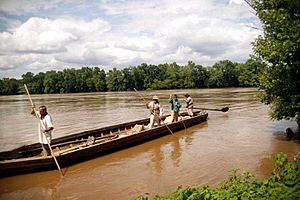James River bateau facts for kids
The James River Bateau was a special type of boat used in Virginia, USA, a long time ago. From about 1775 to 1840, these boats carried things like tobacco and other goods on the James River and its smaller rivers. They were flat on the bottom and pointy at both ends. Most bateaus were about 58 feet (17.5 meters) long. People called "bateaumen" pushed them using long, strong poles. The word "bateau" is French for boat. While similar boats were used elsewhere, this article focuses on the ones from the James River.
Contents
How the Bateau Began
The James River Bateau was invented by Anthony and Benjamin Rucker in 1775. It was a new kind of boat for Virginia's rivers. The Ruckers' design was so good that it was officially patented much later.
One of the first mentions of the bateau comes from Thomas Jefferson's notes. He saw the first one launched on April 19, 1775. Forty-six years later, he even helped the Rucker family get their patent for the boat. George Washington also wrote about the bateau in his diary in 1791. Sadly, none of the original bateaus still exist today. Some parts were found when workers were building the James River and Kanawha Canal.
Carrying Tobacco
The Rucker brothers were tobacco farmers in Amherst County, Virginia. Anthony Rucker even worked as a tobacco inspector. They needed a way to move large barrels of tobacco to the port in Richmond, Virginia. This need likely led them to create the bateau.
The bateau was just wide enough for standard tobacco barrels, called "hogsheads," to fit across its floor. By the 1760s, these hogsheads were usually 48 inches (120 cm) long and 30 inches (76 cm) wide. They could hold about 1,000 pounds (450 kg) of tightly packed tobacco. Bigger bateaus could carry 10 or more of these heavy barrels, depending on the river. Tobacco was a very profitable crop. Many people worked hard to produce huge amounts of it along the James River.
Moving Goods on the James River
The bateau became very useful for carrying other goods and even passengers. Between 1820 and 1840, at least 500 bateaus and 1,500 bateaumen worked on the James River. They traveled between Lynchburg, Virginia and Richmond. Most of the boatmen were African Americans, both those who were enslaved and those who were free.
The use of the bateau greatly decreased after 1840. This was when the James and Kanawha River Canal reached Lynchburg. Other boats, like packet boats, and trains then took over carrying cargo.
How Bateaus Were Built
The James River bateau was made to carry heavy loads and to be easy to steer in the shallow, rocky parts of the Upper James River. In 1775, Thomas Jefferson wrote about buying a bateau. He noted it was "50 feet long, 4 feet wide at the bottom and 6 feet at the top." He also said it could carry 11 hogsheads and only needed 13.5 inches of water when loaded.
Typical bateaus were about 58 feet (17.5 meters) long, but some were shorter or longer. They didn't have a keel (a fin on the bottom) which helped them move through river rapids. They were perfect for shallow water, only needing about 12 to 18 inches (30 to 45 cm) of water when full. They were about 6 to 8 feet (1.8 to 2.4 meters) wide. The sides were usually 18 to 24 inches (45 to 60 cm) high.
Very long wooden planks were attached to ribs to form the sides and bottom. The pointy ends were built separately. This made them easier to fix because the ends often got bumped by river rocks. Bateaus didn't have a rudder to steer. Instead, they were guided by long poles that fit into special notches at the ends. Boats used for cargo didn't have seats. Passenger bateaus sometimes had a roof and places for oars.
James River Batteau Festival
Even though these working bateaus are no longer used, people still remember them. Historians and river lovers keep their memory alive. Replicas of the bateaus have been built, and you can even take bateau river cruises in some places.
Since 1985, the James River Batteau Festival has held a special event. Bateaus travel from Lynchburg to Maiden's Landing in Powhatan. This trip is about 120 river miles (200 km) long. In 2005, seventeen bateau crews and many canoeists took part. By 2009, the number of bateaus in the festival had grown to 25!


